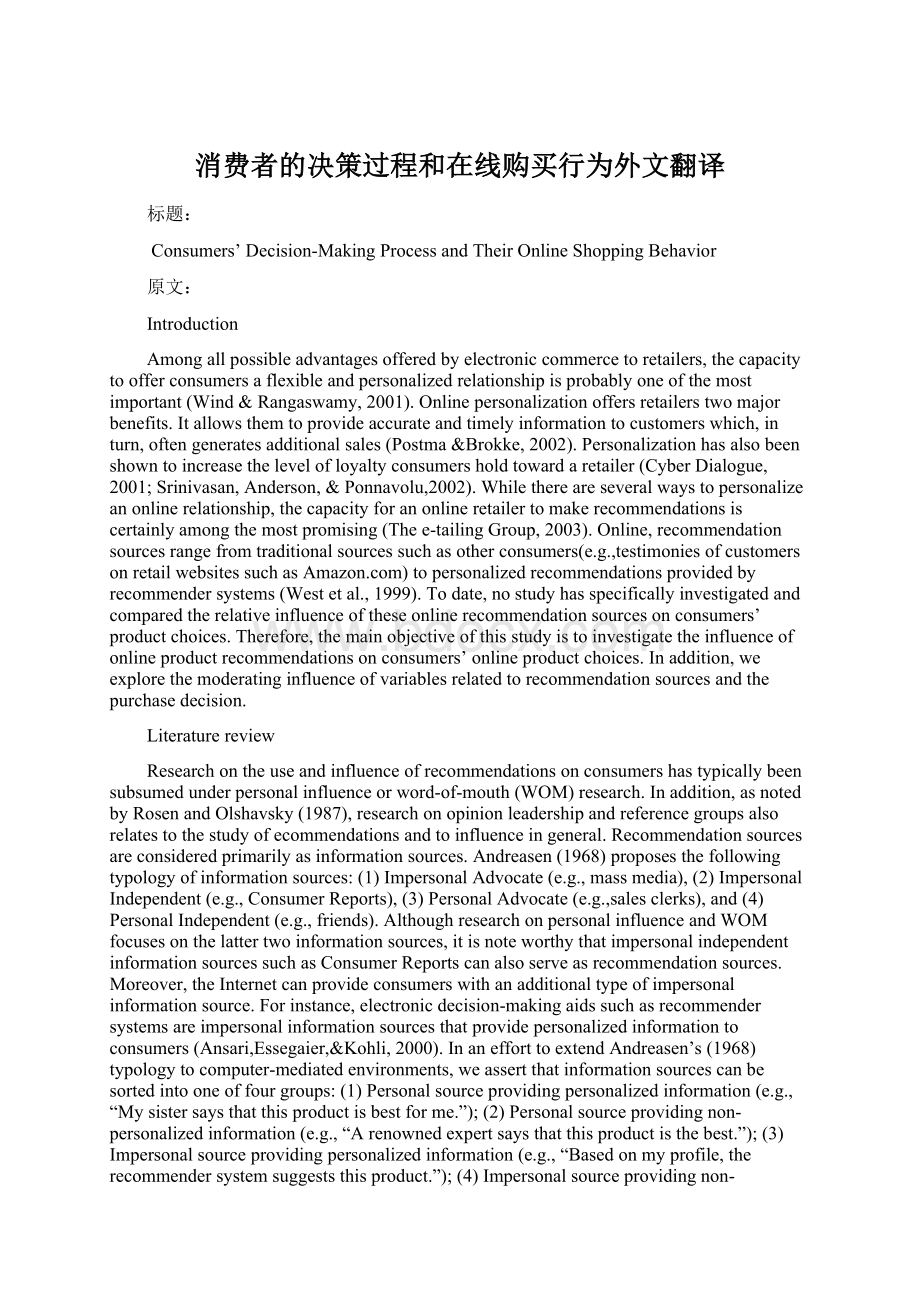消费者的决策过程和在线购买行为外文翻译.docx
《消费者的决策过程和在线购买行为外文翻译.docx》由会员分享,可在线阅读,更多相关《消费者的决策过程和在线购买行为外文翻译.docx(7页珍藏版)》请在冰豆网上搜索。

消费者的决策过程和在线购买行为外文翻译
标题:
Consumers’Decision-MakingProcessandTheirOnlineShoppingBehavior
原文:
Introduction
Amongallpossibleadvantagesofferedbyelectroniccommercetoretailers,thecapacitytoofferconsumersaflexibleandpersonalizedrelationshipisprobablyoneofthemostimportant(Wind&Rangaswamy,2001).Onlinepersonalizationoffersretailerstwomajorbenefits.Itallowsthemtoprovideaccurateandtimelyinformationtocustomerswhich,inturn,oftengeneratesadditionalsales(Postma&Brokke,2002).Personalizationhasalsobeenshowntoincreasethelevelofloyaltyconsumersholdtowardaretailer(CyberDialogue,2001;Srinivasan,Anderson,&Ponnavolu,2002).Whilethereareseveralwaystopersonalizeanonlinerelationship,thecapacityforanonlineretailertomakerecommendationsiscertainlyamongthemostpromising(Thee-tailingGroup,2003).Online,recommendationsourcesrangefromtraditionalsourcessuchasotherconsumers(e.g.,testimoniesofcustomersonretailwebsitessuchasA)topersonalizedrecommendationsprovidedbyrecommendersystems(Westetal.,1999).Todate,nostudyhasspecificallyinvestigatedandcomparedtherelativeinfluenceoftheseonlinerecommendationsourcesonconsumers’productchoices.Therefore,themainobjectiveofthisstudyistoinvestigatetheinfluenceofonlineproductrecommendationsonconsumers’onlineproductchoices.Inaddition,weexplorethemoderatinginfluenceofvariablesrelatedtorecommendationsourcesandthepurchasedecision.
Literaturereview
Researchontheuseandinfluenceofrecommendationsonconsumershastypicallybeensubsumedunderpersonalinfluenceorword-of-mouth(WOM)research.Inaddition,asnotedbyRosenandOlshavsky(1987),researchonopinionleadershipandreferencegroupsalsorelatestothestudyofecommendationsandtoinfluenceingeneral.Recommendationsourcesareconsideredprimarilyasinformationsources.Andreasen(1968)proposesthefollowingtypologyofinformationsources:
(1)ImpersonalAdvocate(e.g.,massmedia),
(2)ImpersonalIndependent(e.g.,ConsumerReports),(3)PersonalAdvocate(e.g.,salesclerks),and(4)PersonalIndependent(e.g.,friends).AlthoughresearchonpersonalinfluenceandWOMfocusesonthelattertwoinformationsources,itisnoteworthythatimpersonalindependentinformationsourcessuchasConsumerReportscanalsoserveasrecommendationsources.Moreover,theInternetcanprovideconsumerswithanadditionaltypeofimpersonalinformationsource.Forinstance,electronicdecision-makingaidssuchasrecommendersystemsareimpersonalinformationsourcesthatprovidepersonalizedinformationtoconsumers(Ansari,Essegaier,&Kohli,2000).InanefforttoextendAndreasen’s(1968)typologytocomputer-mediatedenvironments,weassertthatinformationsourcescanbesortedintooneoffourgroups:
(1)Personalsourceprovidingpersonalizedinformation(e.g.,“Mysistersaysthatthisproductisbestforme.”);
(2)Personalsourceprovidingnon-personalizedinformation(e.g.,“Arenownedexpertsaysthatthisproductisthebest.”);(3)Impersonalsourceprovidingpersonalizedinformation(e.g.,“Basedonmyprofile,therecommendersystemsuggeststhisproduct.”);(4)Impersonalsourceprovidingnon-personalizedinformation(e.g.,“AccordingtoConsumerReports,thisisthebestproductonthemarket.”).Inconsumerresearch,studiesonpersonalinfluence,socialinfluence,orWOM,canbecategorizedasstudiesinvestigatingpersonalsourcesprovidingpersonalizedornon-personalizedinformation.Furthermore,studiesdealingwithreferencegroupsencompasssuchsourcesaswellasimpersonalsourcesthatprovidenon-personalizedinformation.Thus,anewareahasemergedinconsumerresearch,arisingmainlyfrominformationtechnologiessuchastheInternet:
thatofimpersonalsourcesthatprovidepersonalizedinformation(Albaetal.,1997;Ansarietal.,2000;Häubl&Trifts,2000;Maes,1999;Urban,Sultan,&Qualls,1999;Westetal.,1999).Researchoninformationsourcessuggeststhatpersonalandimpersonalinformationsourcesinfluenceconsumers’decision-making(Ardnt,1967;Duhanetal.,1997;Gillyetal.,1998;Olshavsky&Granbois,1979;Price&Feick,1984).Forinstance,PriceandFeick(1984)foundthatconsumersplannedtousethefollowinginformationsourcesfortheirnextdurablegoodpurchase:
(1)Friends,relatives,andacquaintances,
(2)Salespeople,(3)PublicationssuchasConsumerReports.However,ifmuchisknownabouttherelativelikelihoodofconsumerstoconsiderrecommendationsinthecourseoftheirdecisionmakingprocess,littleisknownabouthowrecommendations,especiallyinacomputer-mediatedenvironment,impactconsumers’productchoices.
Determinantsofrecommendationinfluence
Thecurrentstudyfocusesonthreedeterminantsthatcouldinfluencetheimpactofcomputer-mediatedrecommendationsonconsumers’onlineproductchoices:
thenatureoftheproductrecommended,thenatureofthewebsiteonwhichtherecommendationisproposed,andthetypeofrecommendationsource.
Priorresearchhasshownthatthetypeofproductaffectsconsumers’useofpersonalinformationsourcesandtheirinfluenceonconsumers’choices(Bearden&Etzel,1982;Childers&Rao,1992;King&Balasubramanian,1994).Nelson(1970)suggeststhatgoodscanbeclassifiedaspossessing.eithersearchorexperiencequalities.Searchqualitiesarethosethat“theconsumercandeterminebyinspectionpriortopurchase,”andexperiencequalitiesarethosethat“arenotdeterminedpriortopurchase”(Nelson,1974,p.730).Sinceitisdifficultorevenimpossibletoevaluateexperienceproductsbeforepurchase,consumersshouldrelymoreonproductrecommendationsfortheseproductsthanforsearchproducts.Insupportofthisview,KingandBalasubramanian(1994)foundthatconsumersassessingasearchproduct(e.g.,a35-mmcamera)aremorelikelytouseown-baseddecision-makingprocessesthanconsumersassessinganexperienceproduct,andthatconsumersevaluatinganexperienceproduct(e.g.,afilm-processingservice)relymoreonother-basedandhybriddecision-makingprocessesthanconsumersassessingasearchproduct.
Thenatureofthewebsitecanalsoinfluencetheimpactofagivenrecommendation.Basedonpreviouswebsiteclassifications(Hoffman,Novak,&Chatterjee,1995;Spiller&Lohse,1998),SenecalandNantel(2002)suggestthatrecommendationsourcescanbeusedandpromotedbythreedifferenttypesofwebsites:
sellers(e.g.,retailerormanufacturerwebsitessuchasA),commerciallylinkedthirdparties(e.g.,comparisonshoppingwebsitessuchasMyS),andnon-commerciallylinkedthirdparties(e.g.,productormerchantassessmentwebsitessuchasConsumerreports.org).Moreindependentwebsitessuchasnon-commerciallylinkedthirdpartiesthatfacilitateconsumers’externalsearcheffortbydecreasingsearchcostsareassumedtobepreferredbyconsumers(Albaetal.,1997;Bakos,1997;Lynch&Ariely,2000).Byprovidingmorealternativestochoosefromandmoreobjectiveinformation,independentwebsitesshouldbeperceivedasmoreusefulbyconsumers.Inaddition,priorresearchonattributiontheorysuggeststhatconsumersdiscreditrecommendationsfromendorsersiftheysuspectthatthelatterhaveincentivestorecommendaproduct(forreviews,refertoFolkes,1988;Mizerski,Golden,&Kernan,1979).Accordingtothediscountingprincipleoftheattributiontheory(Kelley,1973),whichsuggeststhatacommunicatorwillbeperceivedasbiasediftherecipientcaninferthatthemessagecanbeattributedtopersonalorsituationalcauses,consumerswouldattributemorenon-productrelatedmotivations(e.g.,commissionsonsales)torecommendationsourcesthatarepromotedbycommerciallylinkedthirdpartiesandsellersthanindependentthirdpartywebsites.Consequentlyconsumerswouldfollowproductrecommendationsinagreaterproportionwhenshoppingonmoreindependentthanonlessindependentwebsites.
Inlightofresearchonconsumers’useofrelevantothersintheirpre-purchaseexternalsearchefforts(Olshavsky&Granbois,1979;Price&Feick,1984;Rosen&Olshavsky,1987)andinconsiderationoftheemergenceofonlineinformationsourcesprovidingpersonalizedrecommendations(Ansarietal.,2000),SenecalandNantel(2002)assertthatonlinerecommendationsourcescanbesortedintothreebroadcategories:
(1)otherconsumers(e.g.,relatives,friendsandacquaintances),
(2)humanexperts(e.g.,salespersons,independentexperts),and(3)expertsystemssuchasrecommendersystems.Wepositthattheseonlinerecommendationsourceswillhavedifferentlevelsofinfluenceonconsumers’onlineproductselection.BrownandReingen(1987)suggestthatinformationreceivedfromsourcesthathavesomepersonalknowledgeabouttheconsumerhavemoreinfluenceonthelatterthansourcesthathavenopersonalknowledgeabouttheconsumer.Thus,arecommendationsourceprovidingpersonalizedinformationtoconsumers(e.g.,recommendersystem)shouldbemoreinfluentialthanarecommendationsourceprovidingnon-personalizedinformation(e.g.,otherconsumers).
Thefactthatbothfactors,theorigin(source)ofarecommendationaswellasthetypeofwebsiteonwhichitismade,haveanimpactonthelikelihoodithastobefollowedmayfinditsexplanationinKelman’s(1961)workonsourcecredibility.Kelman(1961)suggeststhatcredibilityisaproductofexpertiseandtrustworthiness.Expertisecanbeviewedastheperceivedabilityofaninformationsourcetoknowtherightanswerandtrustworthinessastheperceivedinformationsource’smotivationtocommunicatethisexpertisewithoutbias(McGuire,1969).Althoughmoderatedbycontextualfactors(forareview,refertoSternthal